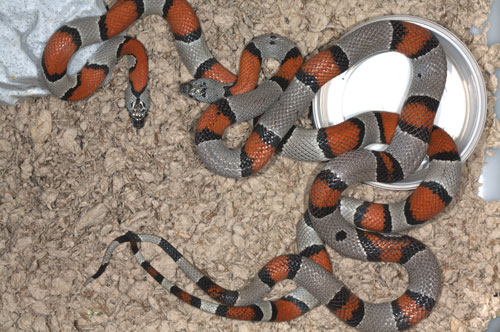Expert breeding tips for the gray-banded kingsnake.
Captive propagation of the gray-banded kingsnake (Lampropeltis alterna) has occurred at least since the 1970s. Most successful propagation of this species follows the rules of temperate colubrid captive breeding. Feeding animals heavily in the summer, fall and spring, coupled with brumating them at 55 degrees Fahrenheit for two to three months in the winter, is necessary for captive breeding. After the spring warm up, breeding usually ensues approximately six weeks to eight weeks later when I introduce the female into the male’s cage.
Eggs are laid six weeks to eight weeks after that. All gravid females will shed one to two weeks prior to egg laying.

Gerold and Cindy Merker
After the spring warm up, breeding usually ensues approximately six weeks to eight weeks later.
Our typical colubrid calendar is as follows.
November 1: Stop feeding all adult snakes.
November 15: Gradually, over a 24-hour period, cool the animal room to approximately 55 degrees.
February 10 to March 1: Heat up animal room and feed animals.
With this schedule, our Lampropeltis alterna lay eggs from mid May until late July, almost like clockwork.
Captive breeding of the gray-banded kingsnake has presented us with various sundry difficulties. From infertile eggs to eggs going full term with normal babies to babies hatching with horrible kinks, we have seen it all. There has been much discussion in gray-banded kingsnake circles regarding the cause of these problems. We strongly feel that vitamin D3 plays a central role in the successful production and hatching of gray-banded kingsnake eggs. We have supplemented the food of our animals twice a month with vitamin/mineral powders and liquid vitamin D3 with great success.
Egg incubation is also the topic of much discussion. We use either vermiculite or perlite to incubate the eggs at approximately 80 degrees. At these temperatures, eggs hatch in 60 to 70 days. Some years, we have large numbers of kinked babies or full-term neonates dying in the egg; other years, there are few or no problems. Some people feel feeding their animals lizards helps with ameliorating these problems. Some breeders also have problems with dystocia or egg binding. A strategy we currently employ is to not feed gravid animals (S. Smith, pers. Comm.). Since we started doing this, our number of egg-bound females has decreased, but we only have one year of personal experience utilizing this strategy.


